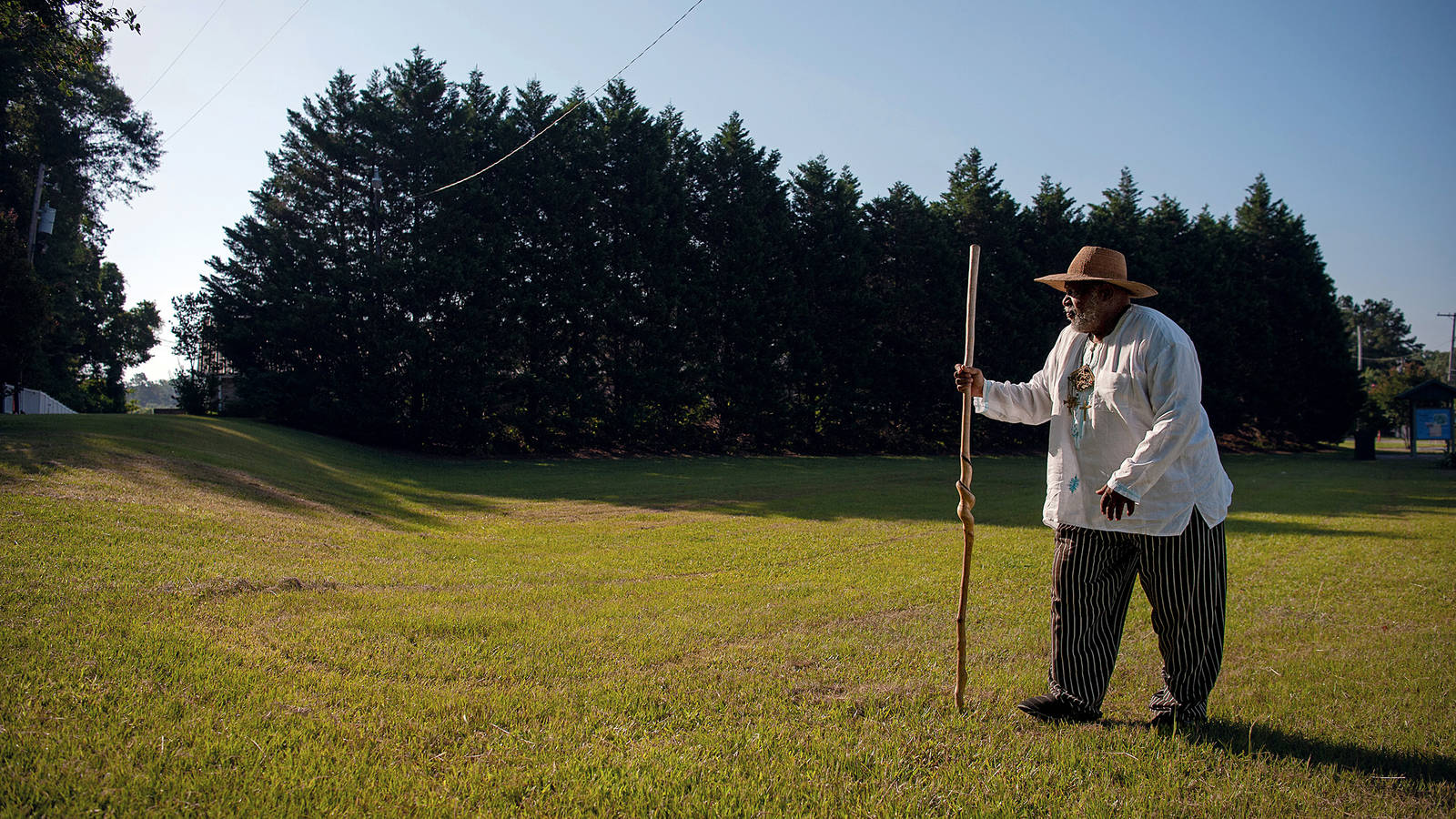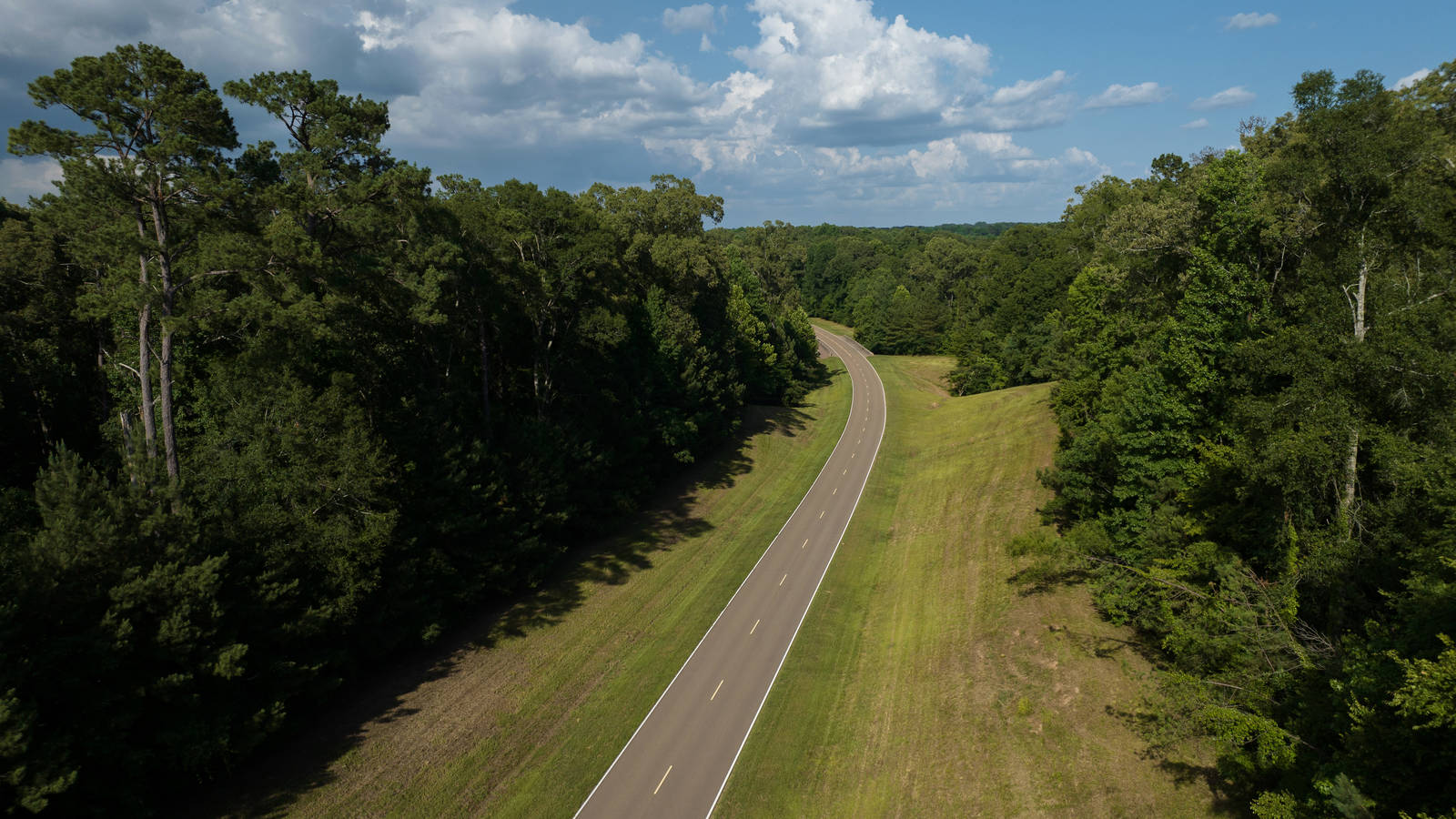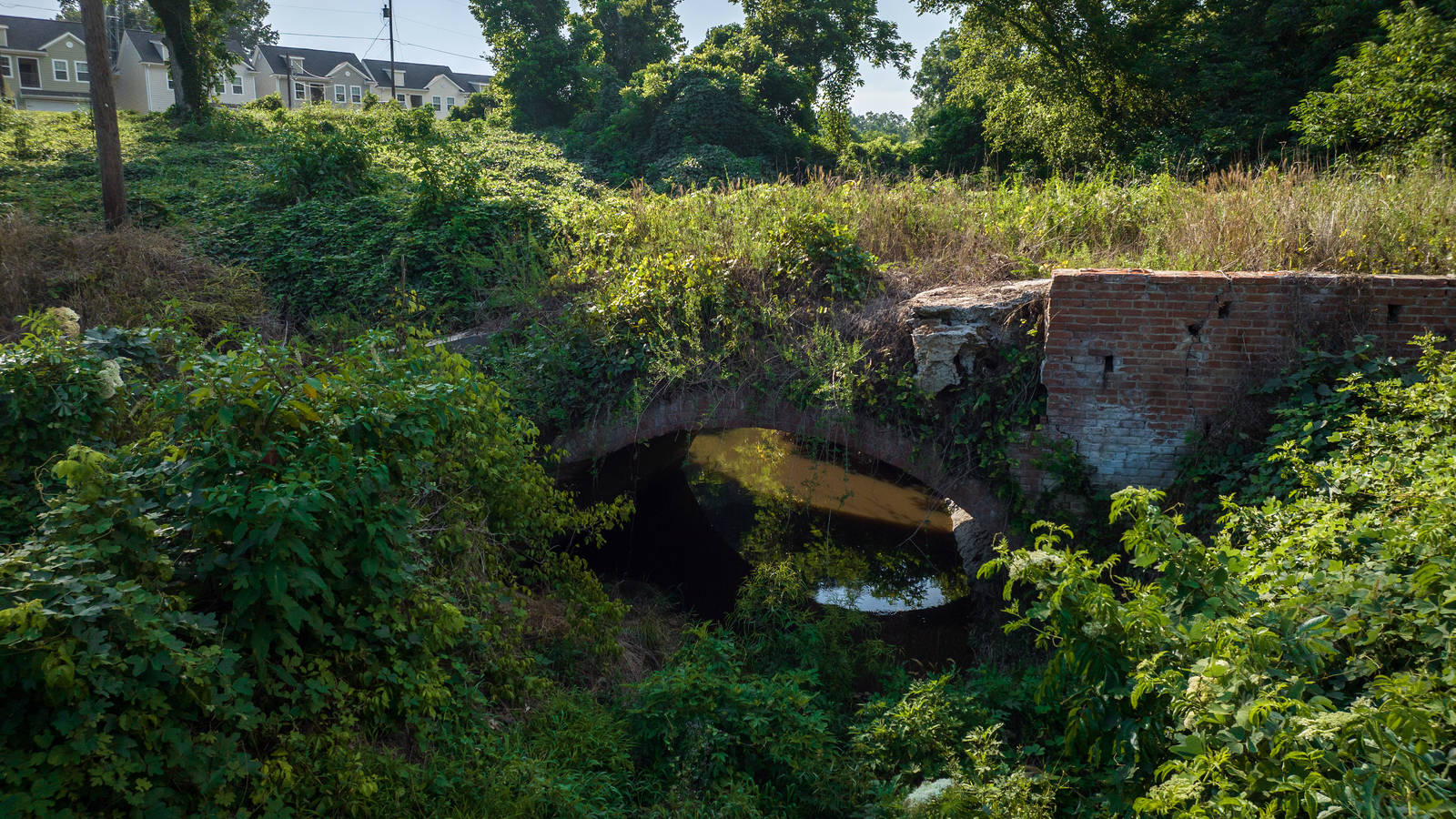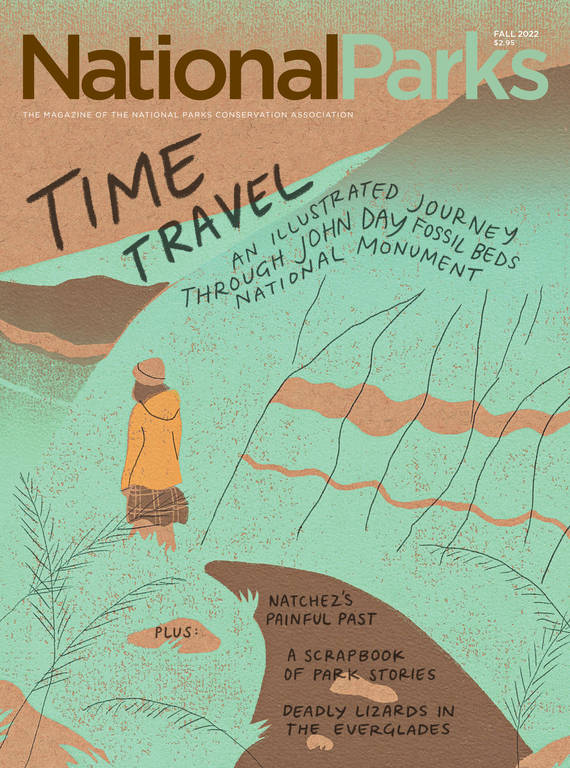Fall 2022
'First, Tell the Truth'
Once one of the largest slave markets in the South, Forks of the Road is now part of the National Park System. Is Natchez ready to excavate its troubled past?
In a section of Natchez, Mississippi, troubled by crumbling streets and abandoned buildings, sits a grassy plot of land less than an acre in size. This piece of Forks of the Road is so small that it’s easy to miss, squeezed between two main thoroughfares that run downtown. One of these, historically called Washington Road, used to connect to the final stretch of the Natchez Trace, a traveling path first used by American Indians and then by European settlers, soldiers and traders — and maintained today by the National Park Service as a scenic parkway and (in spots) as a national scenic trail.
A marker at one end of the patch of land denotes the historic city limits of Natchez; a row of evergreen trees screens the lot from a Kingdom Hall of Jehovah’s Witnesses next door. At garages across the street, workers busily tint car windows and repair mufflers. Traffic is constant.
The junction seems ordinary, but in fact, it hides a devastating chapter in U.S. history: This land and the surrounding 17 acres were once a busy market where slaveholders bought and sold people starting in the 1830s and lasting until 1863, when federal troops enforced President Abraham Lincoln’s Emancipation Proclamation. Tens of thousands of enslaved people passed through, making it the second-largest domestic slave market in the Lower South during the antebellum era. On a recent visit, I found myself looking over the lot and imagining the horror — the coffles, the chains, the dust, the haggling. I could feel sorrow hovering over the place, even generations later, even in the noonday sun.
At the moment, little remains at Forks of the Road to tell its awful story; the only nods to the past are a few interpretive plaques and shackles cemented into the ground. That the site and its story commanded so little attention for most of the last 150 years is hardly surprising: Facing the history of slavery is not exactly a strong suit of the city, which as recently as the 1990s employed the slogan “Come to Natchez, where the Old South still lives.” Tourism has long revolved around the city’s stunning, impeccably restored antebellum homes. Since 1930, thousands of (mostly white) people have taken part in an annual celebration called “Pilgrimage” — guided Garden Club tours of historic homes, where a “Gone With The Wind” ethos has prevailed. The fact that those structures and most of the city were once constructed and maintained by enslaved people was a detail many residents preferred to keep quiet about.
“In Natchez tourism, it was as if whites had done everything,” said Ser Seshsh Ab Heter-C.M. Boxley, a civil rights activist and native son of the city who has been working to rewrite that narrative for decades.
GROWING GAINS
But the commitment to historical whitewashing is slowly fading in this majority-Black city, and Forks of the Road is emblematic of that evolution. In June of 2021, the city of Natchez transferred a piece of the tract where the slave market once thrived to the Park Service. The land became part of Natchez National Historical Park, and plans are underway to commemorate the tragic history of the site, which will eventually extend over 18 acres, as authorized by a federal law passed in 2017.
Kathleen Bond, the superintendent of the historical park, describes Forks of the Road as “a site of conscience.” “This is a major corrective to our historic record — to remind us that human trafficking was a part of our history,” said Bond, who will oversee the development of the site. “I think part of what Forks of the Road has to do is be an agent of healing. That means, first, tell the truth.”
What is the truth of Forks of the Road?
The story starts in the 1700s. By the middle of the 18th century, the last of the Natchez Indians, the region’s native inhabitants, had been driven out. In 1798, the federal government organized the Mississippi Territory, and by the early 1800s, planters were setting up large plantations with cotton as a cash crop. A few events set the stage for this new enterprise. First, as tobacco growing wore out soils in the Upper South, new markets for cotton opened in Europe. Eli Whitney had invented the cotton gin in 1793, and by the early 1800s, steam-powered shipping was coming online. Cotton growing looked profitable, and planters were eager to claim available land. In 1800, the white population of the Mississippi Territory was about 9,000, according to census records, and by 1810 it had grown to over 40,000.
Most adult slaves from the Upper South considered sale into the Deep South a fate worse than death.
Growing cotton required a huge labor force, and plantation owners were willing to enslave, exploit and terrorize people for personal gain. Effective Jan. 1, 1808, however, the U.S. had banned the importation of people in captivity. It had not banned slavery itself. Therefore, until passage of the 13th Amendment in 1865, enslaved people continued to be trafficked domestically.
“Between 1790 and 1860, Americans transported from the Upper South to the Lower South more than 1 million African American slaves,” wrote Steven Deyle in “Carry Me Back: The Domestic Slave Trade in American Life.” Although some who were “sold down the river” would become domestic workers, captive craftsmen or the unpaid bondsmen of merchants in the region’s growing towns, enslaved people usually ended up on “King Cotton” and “Queen Sugar” plantations. “Most adult slaves from the Upper South considered sale into the Deep South a fate worse than death,” Deyle wrote, “with the region’s frontier conditions, subtropical climate, rampant diseases and extreme working conditions.”
Natchez was a major hub of America’s domestic slave trade. Some enslaved men, women and children arrived after being force-shipped by steam-powered brig down the Atlantic Seaboard and across the Gulf of Mexico to New Orleans and then up the Mississippi River to Natchez. Others were shipped down the Ohio River and then the Mississippi. The majority, however, were marched down Old Natchez Trace in coffles guarded by overseers with whips and guns: the Slave Trail of Tears. This roughly three-month journey sometimes covered more than 1,000 miles; enslaved people walked 20 miles a day, slept on hard ground, and were fed hard tack and salt pork purchased along the way. So many people arrived by this route that Old Natchez Trace can be called the second middle passage, the Rev. Tracy Collins, who guides history tours in the area, told me. People chained together, sometimes by the arm and even by the neck, would have turned off the Trace and entered Natchez via Old Washington Road, crossing Spanish Bayou on a bridge and continuing toward the Grid, as locals call Natchez’s downtown, where traders sold enslaved people at small markets or on street corners.
Because of its convenient location at the convergence of many roads, Forks of the Road operated largely as a market for horses, mules and wagons during the early 1800s. This changed suddenly in 1833. Fearing a cholera outbreak, Natchez officials banned slave trading, and slave traders moved immediately outside city limits to Forks of the Road, which became the region’s commercial center for buying and selling human beings. Maps of the era denote the slave pens as “negro marts.”
Writer Joseph Holt Ingraham visited Forks of the Road around 1834 and described the market as “a cluster of rough wooden buildings, in the angle of two roads.” He entered through “a wide gate into a narrow courtyard, partially enclosed by low buildings” and found a semicircle of about 40 enslaved people being examined by potential buyers.
Newspapers from the time advertised new arrivals at the market. In February 1851, for example, trader R.H. Elam posted an advertisement in The Woodville Republican, a local newspaper. The ad’s typos are intact: “I have for sale at the forks of the Road near Natchez, a lot of LIKELY YOUNG NEGNOES. Among them may be found a very superior Blacksmith, Seamstress, &c, &c.”
In 1864, a member of the 12th Wisconsin Infantry repeated what he’d heard about the market from formerly enslaved men in a letter published in the Milwaukee Daily Sentinel. He wrote about “the cruelty of traders, of sad partings of husband and wife, of inhuman fathers selling their own children, and a thousand other incidents illustrating the detestable state of society at the South.”
The economic impact of trafficking at Forks of the Road is stunning. As Collins, the local guide, pointed out, in addition to cotton and sugar, the area produced a third commodity important to world economics: slaves. By the 1840s, Natchez had become one of the wealthiest places in the country.
When the war broke out, Natchez, a Unionist town, voted not to secede. As Bond explained to me, when the Emancipation Proclamation was enforced in Adams County, Mississippi, in 1863, so many Black people joined the Union Army that additional housing was suddenly needed. For a time, Forks of the Road was used as a recruiting station and barracks for the Union Army and a refugee camp, with soldiers and others sleeping in what had been slave pens.
Then the Army ordered Forks of the Road to be torn down so the materials could be used to build barracks at Fort McPherson, on the bluffs overlooking the Mississippi. The job fell to the 6th Regiment of Mississippi Infantry (African Descent), a group of recruits that included African American men who had been sold at the market. “The site was demolished in one night,” Bond said. Nothing remained.
Knowing that human beings were bought and sold as though they were no better or little better than animals … I can’t see how anyone would not feel something standing at Forks of the Road.
After the Civil War ended, a brief period of Reconstruction in Mississippi quickly gave way to Jim Crow’s lynchings, segregation and violence. For generations, Natchez effectively ignored its history of enslavement. “There was a historical amnesia and a mythicizing of the past,” said Jack E. Davis, historian and author of “Race Against Time: Culture and Separation in Natchez Since 1930.” “Those who controlled society controlled history. And whites controlled society. It was a moonlight-on-magnolias version of the past.”
“To some extent this was intentional and to some extent it was indifference to other people’s history,” said Davis. “What was the Black perspective? What would a Black citizen of Natchez say about it? It’s important to know the full past.”
Longtime advocate Ser Seshsh Ab Heter-C.M. Boxley walks across Forks of the Road in Natchez, Mississippi. Owing in part to Ser Boxley’s persistence, the landmark was recently added to Natchez National Historical Park.
©RORY DOYLEThe Rev. Tracy Collins referred to Old Natchez Trace as the second middle passage for its outsize role in the slave trade. Today, that path is roughly defined by the Natchez Trace Parkway, pictured here near Natchez, Mississippi.
©RORY DOYLECoffles of enslaved people once crossed Spanish Bayou on a bridge on their way to Natchez’s downtown.
©RORY DOYLEThat full story — or at least critical parts of it — might have been lost forever were it not for Ser Seshsh Ab Heter-C.M. Boxley, whom I arranged to meet at Forks of the Road. When I arrived, Ser Boxley, born Clifford M. Boxley, was sitting on a granite bench under a row of young crepe myrtles, looking across the spindly grass. Now in his early 80s, he wore an African tunic and black pants with white pinstripes running vertically. Around his neck hung a small leather bag. “Here, people were marketed like cattle and resold into chattel slavery, which benefitted Natchez, Mississippi, and all of America,” he said to me in a deep, booming voice. In his left hand, he held a wooden staff. “Who was telling their story? Who would stand up for them? Who would speak for them?”
Ser Boxley left Natchez in 1960 for California, where he studied urban and regional planning and became active in the civil rights movement. About 35 years later, after several trips to Africa, he felt called to go back permanently to Mississippi and uncover the truth about his enslaved ancestors. Ser Boxley began lobbying to create a memorial and Park Service site at Forks of the Road, an effort that would end up consuming him for more than 20 years. He created a Friends group and arranged countless ceremonies at the site, including its first Juneteenth celebration in 1995. In 2001, Ser Boxley succeeded in getting the Park Service to list Forks of the Road in its National Underground Railroad Network to Freedom, a program that highlights the history of resistance to enslavement (and that NPCA has championed and successfully pushed to fund).
During the time that Ser Boxley was tirelessly campaigning, the Park Service was undergoing dramatic changes in the way it recognized and preserved history, said Barbara Tagger, a Park Service veteran of 40 years who helped usher in that evolution. In the early days, “We were telling stories that excluded a number of groups, especially when it came to the African American experience and especially slavery,” she said. All too many stories were told from the point of view of white sympathizers or white abolitionists, and the perspective of enslaved people was frequently omitted.
To progress, Tagger said, the Park Service had to revise the way it defined history. Previously, rules required sites to be at least 50 years old, and their importance demonstrable with a tangible, well-documented history. But not every site of significance was over 50 years old, and in some places, little physical history remained, or the written record was limited. The document provision proved especially onerous at sites connected to slavery, given that enslaved people were not legally permitted to read or write. “So we had to look at oral traditions too,” Tagger said, when considering designating places without any extant structures.
Forks of the Road benefited from this shift and also from a greater willingness in places like Natchez to look at the past — and the slave trade, in particular — in a clear-eyed way. “There were some terrible things that happened,” said Natchez Mayor Dan M. Gibson. “It’s a story that has not been told for so long. And it must be told.”
Deborah Fountain is among those who believe that Natchez is ready and willing to change. Fountain, who was raised in Kansas City but has maintained a connection to her ancestral home in Mississippi, serves as a leader of the Natchez U.S. Colored Troops Monument Committee, which is in the process of erecting a memorial honoring those African American servicemen. “It is high time that those who had been nameless, faceless people are given credit for their service,” she said.
ABOUT THE PHOTOGRAPHER
A genealogist for more than 30 years, Fountain has uncovered nine ancestors who served in the Colored Troops in Natchez. One of them, her great-great-grandfather Claiborne Thompson, was enslaved on Kinnison Plantation in the Natchez District. U.S. Census files list his mother as Mary Thompson, who was born “on the ocean” and sold into the Lower South. Fountain is not (yet) sure how her family history intersects with Forks of the Road, but she is a strong supporter of the plan to develop the site. “For me,” Fountain said, “knowing the sheer volume of slave trading that took place in that location, knowing that human beings were bought and sold as though they were no better or little better than animals, that crimes against humanity occurred, I can’t see how anyone would not feel something standing at Forks of the Road.”
Bond expects the site will eventually include a visitor center, a memorial and a place for contemplation. She hopes that one day, visitors will be able to walk the route many enslaved people walked, traveling south along the Natchez Trace, crossing a bridge over Spanish Bayou and marching uphill to the old market. “It’s critical to provide visitors the opportunity to walk that road because that experience, horrific as it is, is a part of the American experience,” she said. In addition, Bond would like to establish a genealogy research facility to help descendants of enslaved people locate ancestors who were trafficked at Forks of the Road. “Enslaved people at multiple points in their lineage were stripped of identity and shipped to a different place,” she said. She believes that genealogical research can repair some of the damage of these dislocations.

National Parks
You can read this and other stories about history, nature, culture, art, conservation, travel, science and more in National Parks magazine. Your tax-deductible membership donation of $25 or more entitles…
See more ›A limited 2007 archaeological dig that the city requested — and the Park Service funded — failed to uncover artifacts from the era of slavery. That, Bond believes, is due to massive ground disturbance that happened decades after the closure of the slave market, for road building and other construction. Bond plans to conduct a more comprehensive archaeological dig.
Gibson, the mayor, said that at one time, when slavery flourished, Natchez could have been described as “first in hate,” but he thinks it’s possible for the city to embody a new identity and become “first in love.” Indeed, Natchez has an opportunity to become a model, Bond said, and to demonstrate how other places and their denizens can honestly face the past, even when it’s deplorable or tragic. “If we can do it in Natchez,” she said, “we can do it anywhere.”
About the author
-
 Janisse Ray Contributor
Janisse Ray ContributorJanisse Ray’s collection of essays, “Wild Spectacle: Seeking Wonder in a World Beyond Humans,” came out in 2021. She is at work on a book tracing the movement to honor the Muscogee (Creek) homeland in central Georgia with a national park.






